Also, according to Putin in his briefing with Shoigu, the military personnel on board was rather exceptional on military achievement and rank. It seems like a big blow to the russians considering who was on board. Out of the 14 people that died, Putin said that two "heroes of Russia" and seven "captains of first rank" were killed. Putin also said according to some translations that both he and Shoigu know that this was "no ordinary vessel" with a "highly qualified crew":
You are using an out of date browser. It may not display this or other websites correctly.
You should upgrade or use an alternative browser.
You should upgrade or use an alternative browser.
Events in Russia
- Thread starter youlik
- Start date
angelburst29
The Living Force
Also, according to Putin in his briefing with Shoigu, the military personnel on board was rather exceptional on military achievement and rank. It seems like a big blow to the Russians considering who was on board. Out of the 14 people that died, Putin said that two "heroes of Russia" and seven "captains of first rank" were killed. Putin also said according to some translations that both he and Shoigu know that this was "no ordinary vessel" with a "highly qualified crew":
As stated in a previous Post, it was noted that "Russia will be holding an annual naval parade on July 29th". It was established by order of President Vladimir Putin on July 27, 2017 as the principal anniversary event in connection with Navy Day celebrations. The Russian Vladikavkaz, was sailing "in surface position" through the Barents and Norwegian seas, heading towards St. Petersburg. The Northern Fleet has regularly sailed "a nuclear submarine" to the naval parade in St. Petersburg. Also, included in this year's naval parade, the newest frigate Admiral Gorshkov.
The Losharik, described by one source as "nuclear-powered" and "the most silent and hard-to-detect submarine in the Navy of
able to dive to a depth of 6,000 meters" ... suffered "an incident/fire" while it was located in the Barents sea, reason I suggested it was following the same route, as the Vladikavkaz to St. Petersburg. If the Losharik was scheduled to also attend the naval parade, it may account for the presents of a large number of high caliber Naval officers on the sub?
At the time of the Losharik incident, NATO was gathering in the Norwegian Sea for it's annul anti-submarine exercise Dynamic Mongoose, slated for July 2-14. The Naval Group consisted of British and Turkish frigates and the U.S. Flagship guided missile destroyer USS Gravely. "The U.S. is playing a key role in preparing the drills scenario and executing it." NATO had to have all the ships, personnel and frigates in place, prior to commencement of it's drills - so they were all on active duty.
My opinion is that the USS Gravely had something to do with what happened to the nuclear submarine Losharik.
The incident accomplished at least three things ...
* located and damaged a highly classified Russian submarine
* inflicted serious casualties and death upon dedicated and skilled professionals in Russian waters
* the incident and deaths overshadow President Putin's/Defense Minster Sergey Shoigu's annual Naval Parade
Getting back to the article, the Russian Vladikavkaz was heading toward St. Petersburg, to take part in the annual naval parade, that's being held this year on July 29th.
While NATO is preparing the anti-submarine warfare exercises, Russia's Northern Fleet submarine Vladikavkaz has sailed out from Polyarny on the Kola Peninsula and is right now en route south toward St. Petersburg where it will take part in the annual naval parade.
The state-run Rossiiskaya Gazeta quoted the head of the Northern Fleet’s press service, Vadim Serga, as saying that Vladikavkaz will sail in surface position all the way through the Barents and Norwegian Seas.
The article goes on to state:
Over the last few years, the Northern Fleet has regularly sailed a nuclear-submarine to the naval parade in St. Petersburg.
In addition to Vladikavkaz, several other ships from the Northern Fleet will be in St. Petersburg, including the newest frigate Admiral Gorshkov, which will soon sail across the Atlantic after recent visits to China and Cuba.
I'm going to take a giant leap of faith and suggest "the Losharik" was the nuclear submarine/submersible vehicle following the Vladikavkaz in route to St. Petersburg, also to take part in the naval parade. It would give a reasonable explanation, as to why, there were "seven Captain First Rank officers - the most Senior Staff Officers in the Russian Navy - and two that have been awarded "Hero of Russia", a top title given out by the President".
angelburst29
The Living Force
Report to the President: super-secret submarine «Losharik» will be repaired and taken back in service
Report to the President: super-secret submarine «Losharik» will be repaired and taken back in service
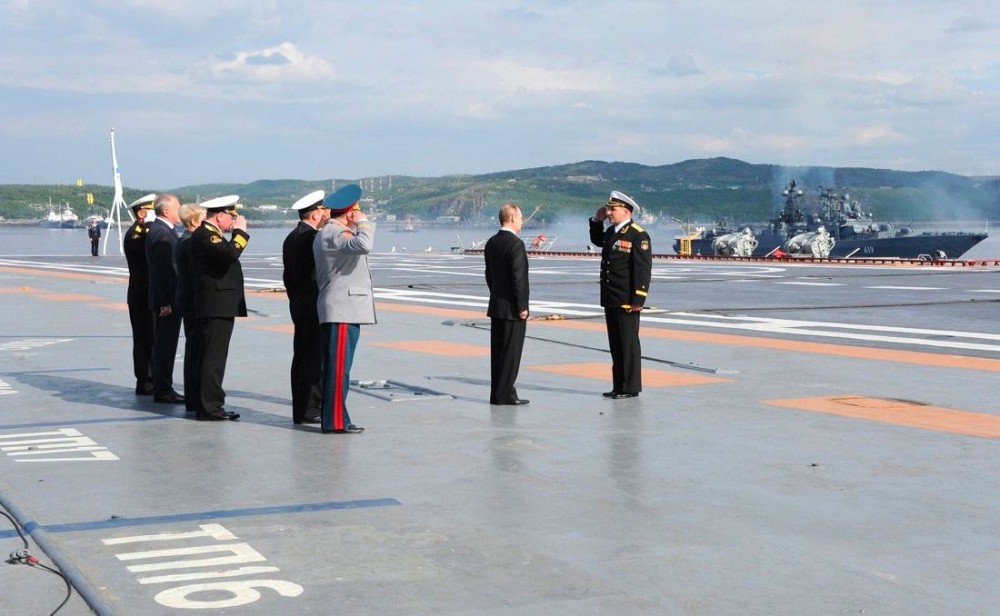
Vladimir Putin pays visit to Northern Fleet headquarters Severomorsk in 2014. Photo: Kremlin.ru
July 04, 2019 - According to the defense minister, the special purpose submarine can be fully restored and taken back in service. Sergey Shoigu in Thursday morning met with President Putin following his trip to Severomorsk, the Northern Fleet headquarters, on Wednesday.
«The constructors of the vessel and industrial representatives have been engaged in order to estimate the work volume and time period needed for the restoration of the ship,» Shoigu told the President.
«Our first assessment shows that repair is possible, [and] in our case it is not only possible, it it absolutely required,» the defense minister underlined.
He also made clear that the reactor compartment is unaffected by the accident. It is isolated and without people, he told Putin.
«The crew did all required measures to protect the installation, it is in a fully workable condition, and this makes us hope that the vessel can be restored in pretty short time.»
The fire onboard the «Losharik» (AS-31) broke out in the evening of 1 July. A total of 14 sailors died. Among them where two highly decorated Heroes of Russia, seven 1st rang captains and three 2nd rang captains. The crew included some of the the most experienced men in the Russian Navy.
The vessel reportedly was in Russian territorial waters when the fire started. Fishermen were eye witnesses to the ship when it suddenly surfaced near the Ura Bay, about 100 km east of the border to Norway.
The Ministry of Defense on Wednesday released the list of the dead. The «Losharik» was headed by ship captain Denis Dolonsky, 1st rang captain and Hero of Russia.
Two of the dead come from Murmansk, news agency SeverPost informs. The remaining parts of the crew came from St. Petersburg.
According to the Russian Armed Forces, a special crew is now following up the families of the dead. Material support will be provided and the studies and education of the children involved will be taken care of.
US cruiser impeded Russian warship’s passage in East China Sea
US cruiser impeded Russian warship’s passage in East China Sea

Admiral Vinogradov anti-submarine destroyer © Sergei Orlov/TASS
MOSCOW, June 7, 2019 - Russia has voiced a protest to the US command after its guided-missile cruiser hindered the passage of the Admiral Vinogradov anti-submarine destroyer some 50 meters in front of it, forcing the vessel to perform a dangerous maneuver, the Pacific Fleet's press service told reporters on Friday.
The incident occurred at 6.35 a.m. Moscow Time in the southeastern part of the East China Sea, when a task force of the Russian Pacific Fleet and a US carrier strike group were heading in parallel directions. "The US cruiser Chancellorsville suddenly changed its course and crossed the Admiral Vinogradov destroyer’s course some 50 meters away from the ship. In order to prevent a collision, the Admiral Vinogradov’s crew was forced to conduct an emergency maneuver," the press service said.
The Pacific Fleet voiced a protest to the US vessel’s command, stressing that such steps are unacceptable.
Large anti-submarine ships of Project 1155 are designed to fight adversary nuclear submarines in the ocean zone, ensure the operation of Russian submarines and protect surface warships. The Admiral Vinogradov destroyer and the Chancellorsville cruiser have a full displacement of 7,500 tonnes and 9,800 tonnes, respectively.
New Details on Russian Submarine Fire Emerge Along With an Intriguing Schematic (Updated) (Photos)
New Details On Russian Submarine Fire Emerge Along With An Intriguing Schematic (Updated)

via Top Gear Russia
A reported picture of Losharik running on the surface.
Krasnaya Zvezda, the official newspaper of the Russian Ministry of Defense, has included a heretofore unseen drawing of the Project 09852 Belgorod, a heavily modified Oscar II-class submarine outfitted for various "special projects" missions, in its latest report about a fire that killed 14 sailors onboard a still-unnamed Russian submarine on Monday. Russia officially launched the still-under-construction Belgorod, which is presently the world's longest submarine, in April 2019. At the same time, new details regarding the July 1st accident have begun to trickle out, although they are limited in number and some are unconfirmed in nature.
Though Belgorod is more widely associated with the Poseidon nuclear-powered and nuclear-armed long-range torpedo, this special mission boat will also be capable of serving as a mothership for smaller, highly specialized, and deep-diving submarines, such as the Project 10831 Losharik. Independent Russian media outlets have widely reported that Losharik, also known by the hull number AS-12 and more recently AS-31, was the submarine that experienced the deadly blaze on July 1, 2019. You can find more details about Losharik and what is known so far about this accident in The War Zone's earlier extensive coverage of the incident here.
(Article continues.)
Report to the President: super-secret submarine «Losharik» will be repaired and taken back in service

Vladimir Putin pays visit to Northern Fleet headquarters Severomorsk in 2014. Photo: Kremlin.ru
July 04, 2019 - According to the defense minister, the special purpose submarine can be fully restored and taken back in service. Sergey Shoigu in Thursday morning met with President Putin following his trip to Severomorsk, the Northern Fleet headquarters, on Wednesday.
«The constructors of the vessel and industrial representatives have been engaged in order to estimate the work volume and time period needed for the restoration of the ship,» Shoigu told the President.
«Our first assessment shows that repair is possible, [and] in our case it is not only possible, it it absolutely required,» the defense minister underlined.
He also made clear that the reactor compartment is unaffected by the accident. It is isolated and without people, he told Putin.
«The crew did all required measures to protect the installation, it is in a fully workable condition, and this makes us hope that the vessel can be restored in pretty short time.»
The fire onboard the «Losharik» (AS-31) broke out in the evening of 1 July. A total of 14 sailors died. Among them where two highly decorated Heroes of Russia, seven 1st rang captains and three 2nd rang captains. The crew included some of the the most experienced men in the Russian Navy.
The vessel reportedly was in Russian territorial waters when the fire started. Fishermen were eye witnesses to the ship when it suddenly surfaced near the Ura Bay, about 100 km east of the border to Norway.
The Ministry of Defense on Wednesday released the list of the dead. The «Losharik» was headed by ship captain Denis Dolonsky, 1st rang captain and Hero of Russia.
Two of the dead come from Murmansk, news agency SeverPost informs. The remaining parts of the crew came from St. Petersburg.
According to the Russian Armed Forces, a special crew is now following up the families of the dead. Material support will be provided and the studies and education of the children involved will be taken care of.
Russia's Pacific Fleet has logged a complaint to the U.S. command of the Chancellorsville cruiser for the incident in the East China Sea.
The Pacific Fleet voiced a protest to the US vessel’s command.
US cruiser impeded Russian warship’s passage in East China Sea
US cruiser impeded Russian warship’s passage in East China Sea

Admiral Vinogradov anti-submarine destroyer © Sergei Orlov/TASS
MOSCOW, June 7, 2019 - Russia has voiced a protest to the US command after its guided-missile cruiser hindered the passage of the Admiral Vinogradov anti-submarine destroyer some 50 meters in front of it, forcing the vessel to perform a dangerous maneuver, the Pacific Fleet's press service told reporters on Friday.
The incident occurred at 6.35 a.m. Moscow Time in the southeastern part of the East China Sea, when a task force of the Russian Pacific Fleet and a US carrier strike group were heading in parallel directions. "The US cruiser Chancellorsville suddenly changed its course and crossed the Admiral Vinogradov destroyer’s course some 50 meters away from the ship. In order to prevent a collision, the Admiral Vinogradov’s crew was forced to conduct an emergency maneuver," the press service said.
The Pacific Fleet voiced a protest to the US vessel’s command, stressing that such steps are unacceptable.
Large anti-submarine ships of Project 1155 are designed to fight adversary nuclear submarines in the ocean zone, ensure the operation of Russian submarines and protect surface warships. The Admiral Vinogradov destroyer and the Chancellorsville cruiser have a full displacement of 7,500 tonnes and 9,800 tonnes, respectively.
New Details on Russian Submarine Fire Emerge Along With an Intriguing Schematic (Updated) (Photos)
New Details On Russian Submarine Fire Emerge Along With An Intriguing Schematic (Updated)

via Top Gear Russia
A reported picture of Losharik running on the surface.
Krasnaya Zvezda, the official newspaper of the Russian Ministry of Defense, has included a heretofore unseen drawing of the Project 09852 Belgorod, a heavily modified Oscar II-class submarine outfitted for various "special projects" missions, in its latest report about a fire that killed 14 sailors onboard a still-unnamed Russian submarine on Monday. Russia officially launched the still-under-construction Belgorod, which is presently the world's longest submarine, in April 2019. At the same time, new details regarding the July 1st accident have begun to trickle out, although they are limited in number and some are unconfirmed in nature.
Though Belgorod is more widely associated with the Poseidon nuclear-powered and nuclear-armed long-range torpedo, this special mission boat will also be capable of serving as a mothership for smaller, highly specialized, and deep-diving submarines, such as the Project 10831 Losharik. Independent Russian media outlets have widely reported that Losharik, also known by the hull number AS-12 and more recently AS-31, was the submarine that experienced the deadly blaze on July 1, 2019. You can find more details about Losharik and what is known so far about this accident in The War Zone's earlier extensive coverage of the incident here.
(Article continues.)
angelburst29
The Living Force
Russia nuclear sub fire could have caused catastrophe: report cites navy official
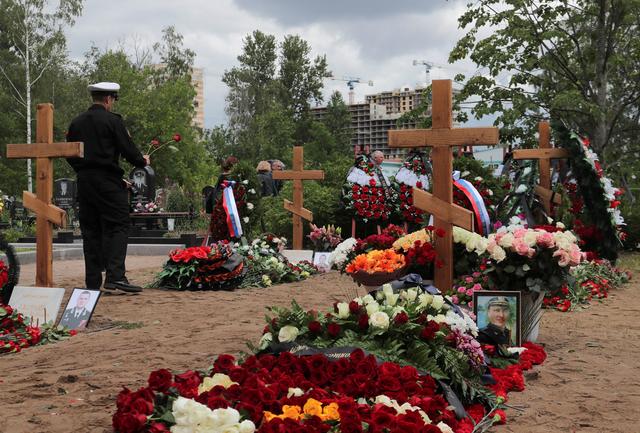
People attend the funeral of Russian sailors, who were recently killed in a fire on a secret nuclear research submarine in the area of the Barents Sea, at Serafimovskoye cemetery in Saint Petersburg, Russia July 6, 2019. REUTERS/Anton Vaganov
A fire aboard a top-secret Russian nuclear submarine could have led to a “catastrophe of global proportions” if not for the selfless actions of the crew, a senior navy official was cited by a Russian media outlet as saying.
Fourteen submariners were killed on July 1 during a fire in a deep-water research submersible that was surveying the sea floor near the Arctic, according to Russia’s Defence Ministry.
Russian officials have faced accusations of trying to cover up the full details of the incident on the top secret vessel. President Vladimir Putin only acknowledged publicly there had been a nuclear reactor on board three days after it happened.
The sailors were buried on Saturday in St Petersburg at a funeral ceremony that was closed to the public.
“They all shared one and the same fate - to save the lives of their comrades, to save their vessel and to prevent a catastrophe of global proportions at the cost of their own lives,” Sergei Pavlov, an aide to the Russian navy’s commander, was quoted as saying at the funeral by St Petersburg media outlet Fontanka on Saturday.
In the comments from Pavlov quoted in Russian media, there was no explanation of how the fire could have resulted in a global catastrophe. Russian officials have said the crew contained the fire and isolated the submarine’s nuclear reaction.
Kremlin spokesman Dmitry Peskov, told reporters on a conference call he was unaware of the comments made by officials at the funeral and was therefore unable to comment.
Putin last week bestowed Russia’s highest state award - the title of Hero of Russia - on four of the men and granted another top state award — the Order of Courage — to the 10 others.
Putin has said that the submarine was manned by an elite and senior crew, two of whom already held the Hero of Russia title before their final mission.
People attend the funeral of Russian sailors, who were recently killed in a fire on a secret nuclear research submarine in the area of the Barents Sea, at Serafimovskoye cemetery in Saint Petersburg, Russia July 6, 2019. REUTERS/Anton Vaganov
A fire aboard a top-secret Russian nuclear submarine could have led to a “catastrophe of global proportions” if not for the selfless actions of the crew, a senior navy official was cited by a Russian media outlet as saying.
Fourteen submariners were killed on July 1 during a fire in a deep-water research submersible that was surveying the sea floor near the Arctic, according to Russia’s Defence Ministry.
Russian officials have faced accusations of trying to cover up the full details of the incident on the top secret vessel. President Vladimir Putin only acknowledged publicly there had been a nuclear reactor on board three days after it happened.
The sailors were buried on Saturday in St Petersburg at a funeral ceremony that was closed to the public.
“They all shared one and the same fate - to save the lives of their comrades, to save their vessel and to prevent a catastrophe of global proportions at the cost of their own lives,” Sergei Pavlov, an aide to the Russian navy’s commander, was quoted as saying at the funeral by St Petersburg media outlet Fontanka on Saturday.
In the comments from Pavlov quoted in Russian media, there was no explanation of how the fire could have resulted in a global catastrophe. Russian officials have said the crew contained the fire and isolated the submarine’s nuclear reaction.
Kremlin spokesman Dmitry Peskov, told reporters on a conference call he was unaware of the comments made by officials at the funeral and was therefore unable to comment.
Putin last week bestowed Russia’s highest state award - the title of Hero of Russia - on four of the men and granted another top state award — the Order of Courage — to the 10 others.
Putin has said that the submarine was manned by an elite and senior crew, two of whom already held the Hero of Russia title before their final mission.
angelburst29
The Living Force
Putin says he does not want Russia to impose sanctions on Georgia

Russian President Vladimir Putin said in televised comments on Tuesday that he did not support a parliamentary call to impose tough economic sanctions on Georgia.
Putin opposes Russian parliament call for Georgia sanctions

Russian President Vladimir Putin rejected on Tuesday a parliamentary call to impose sanctions against Georgia, saying patching up strained relations was more important than reacting to provocations by "scumbags".
European Court says Russia not facing up to domestic abuse problem

Russia failed to protect a woman from repeated acts of violence by her former partner, the European Court of Human Rights ruled on Tuesday, saying her case showed that Moscow was not facing up to its domestic abuse problem.
Russia's Putin says wind power harmful to birds and worms

Russia's President Vladimir Putin makes comments on the country's bilateral relations with Georgia as he attends the Global Manufacturing and Industrialisation Summit (GMIS) in Yekaterinburg, Russia July 9, 2019. Sputnik/Alexei Druzhinin/Kremlin
Russian President Vladimir Putin questioned on Tuesday the use of wind power, saying wind turbines were harmful to birds and worms.
Russia, a world-leading producer of fossil fuel, is lagging other countries in its development of renewable energy sources, such as solar and wind-powered energy.
Wind power is rarely used in the country to generate electricity. Enel Russia pledged 90 million euros to build a power generation facility by 2024 with a capacity of 71 megawatts.
“Wind-powered generation is good, but are birds being taken into account in this case? How many birds are dying?” Putin said at a televised conference on industry in the Russian city of Yekaterinburg.
“They (wind turbines) shake, causing worms to come out of the soil. This is not a joke,” he said.
Putin added that people would not like to live on a planet dotted with “rows of wind-powered generators and covered by several layers of solar panels”.
Russian President Vladimir Putin said in televised comments on Tuesday that he did not support a parliamentary call to impose tough economic sanctions on Georgia.
Putin opposes Russian parliament call for Georgia sanctions
Russian President Vladimir Putin rejected on Tuesday a parliamentary call to impose sanctions against Georgia, saying patching up strained relations was more important than reacting to provocations by "scumbags".
European Court says Russia not facing up to domestic abuse problem
Russia failed to protect a woman from repeated acts of violence by her former partner, the European Court of Human Rights ruled on Tuesday, saying her case showed that Moscow was not facing up to its domestic abuse problem.
Russia's Putin says wind power harmful to birds and worms
Russia's President Vladimir Putin makes comments on the country's bilateral relations with Georgia as he attends the Global Manufacturing and Industrialisation Summit (GMIS) in Yekaterinburg, Russia July 9, 2019. Sputnik/Alexei Druzhinin/Kremlin
Russian President Vladimir Putin questioned on Tuesday the use of wind power, saying wind turbines were harmful to birds and worms.
Russia, a world-leading producer of fossil fuel, is lagging other countries in its development of renewable energy sources, such as solar and wind-powered energy.
Wind power is rarely used in the country to generate electricity. Enel Russia pledged 90 million euros to build a power generation facility by 2024 with a capacity of 71 megawatts.
“Wind-powered generation is good, but are birds being taken into account in this case? How many birds are dying?” Putin said at a televised conference on industry in the Russian city of Yekaterinburg.
“They (wind turbines) shake, causing worms to come out of the soil. This is not a joke,” he said.
Putin added that people would not like to live on a planet dotted with “rows of wind-powered generators and covered by several layers of solar panels”.
Although the cause of fire is not known yet, and most likely won't be reveiled to the public ever, like the particular mission itself, there are some new details (if true) in a recent RBC article. In DeepL/Google translation:
Last expedition: what could have killed 14 submarine officers
09/07/2019
After the Losharik submarine tragedy, RBC's correspondent visited the Murmansk region to understand the details of the classified incident in the Barents Sea
The materials of the commission headed by Navy chief Nikolai Yevmenov are not available even to the acting head of Murmansk region Andrei Chibis. The details of the incident belong to the state secret. Relatives of the dead and injured had to sign non-disclosure papers. RBC correspondent visited Murmansk region and talked to representatives of regional authorities, military personnel and acquaintances about the investigation of the tragedy to restore the chronology of the incident in the Barents Sea.
Explosion in the Motov Bay
The nuclear powered deep-water station of project 10831 AS-31 ("Losharik") and its base station, the nuclear submarine "Podmoskovye", are assigned to the 29th division, which is located in the village of Olenya Guba on the western coast of the Kola Bay, a source familiar with the details of the incident told RBC, and a second interlocutor familiar with the investigation confirmed it.
On July 1 at about 9 p.m., a nuclear submarine docked with the base station left Olenya Guba and, presumably, went to the northwest to Motovka Bay. In this bay there is a test site where Russian submarines dived to the extreme depths of 600 m, explains a former submariner who served in the region. After completion of the task, the nature of which is not specified, "Losharik" went up and docked with the carrier boat, and then an emergency occurred. This very circumstance allowed to save a part of the crew and the station itself.

According to preliminary data, the fire and explosion occurred in the nose compartment where the battery was located, said another RBC interlocutor familiar with the commission's work. This information was also confirmed by the interlocutor who is familiar with the progress of the investigation. The accident happened precisely at the deep-water station АС-31, and not on the carrier boat.
The exact number of people at AS-31 was not disclosed at the time of the fire. Officially announced 14 dead. "There are 24 berths on the submarine," said the interlocutor who took part in such exercises. In addition to the 14 dead and five injured, the boat could accomodate five more, he suggested. There is no data about them and there will not be, given the secrecy of the operation, the interlocutor added. All those on the boat known to be present were officers. Of the 14 dead, seven were first rank captains. "This is a normal composition for such a submarine. Specially trained people work at such depths. The crew of the AS-31 does not include conscripts, but only officers," he explained.
Defense Minister Sergei Shoigu said that part of the crew was rescued, but did not specify the number of survivors. Five of the injured were in a closed ward of the North Sea hospital, all of them received contusions, but by Thursday, July 4, everyone had regained consciousness, said a source familiar with the investigation. According to him, everyone was discharged on Saturday so that they could attend the funeral of their colleagues.
The only civilian on board, in all likelihood, was a representative of the Sevmash factory, which builds submarines, and carried out the adjustment of mechanisms, noted a sailor familiar with the circumstances of the emergency. The servicemen do not set up the equipment themselves, they only operate it, he explains, while maintenance work is carried out by specialists from the manufacturers. "The ship went out to sea, they had to work on some tasks. I suppose it was a training exit to check the readiness of the ship," says the submariner.
Rescue of a civilian and unused gas masks
"The commission raises questions about the cause of the explosion in the compartment where the battery was located, as well as the fact that the sailors did not use portable breathing apparatus, which, according to the instructions, should have been used first of all," says a RBC interviewee familiar with the investigation into the circumstances.
It is, most likely, a lithium-ion rechargeable battery that was believed to be absolutely safe, says another experienced submariner. "Not a single serious accident on these batteries happened in the 45 years of the submarines' existence," he emphasizes. The lithium battery is a backup power source on this nuclear submarine, another former submariner explains.
Each submariner, among other things, has a portable breathing apparatus (PBA) - a red box containing a gas mask and a closed-loop breathing device, as confirmed by a submariner familiar with the deceased crew members. The PBA allows you to fight for up to 20 minutes for the survivability of the boat despite the products of combustion, he said. In addition, the sailors had insulating /self-contained gas masks (IP-6): when the air in the PBA ran out, they had to switch to IP-6, whose regenerative cartridge allows them to hold on for another 40 minutes, he explains.
Probably, the sailors did not have time to use the means of protection because of the explosion - someone died immediately, and someone lost consciousness and suffocated before wearing the PBA. It is possible that someone was not on the watch and slept, RBC's interlocutor suggests. In a submarine of this type two or three breaths is enough to be poisoned by the products of combustion and lose consciousness, the submariner explains.
The deceased sailors were in the bow section of the submarine, four others were in the central section, they were not involved in the docking and managed to get into the carrier boat, said the interlocutor, familiar with the circumstances of the tragedy. The civilian was in the bow compartment, he was evacuated from there, he said.
It is not known exactly how the civilian was evacuated and the bow section isolated. The official report of the Ministry of Defense states that Captain Dmitri Solovyov, the second rank captain, took the civilian out of the compartment and battered down the hatch. If the hatch was blocked by one of the seamen who died later, he probably had a few seconds to do so - and in that case, one can assume that he decided not to spend time to connect to the PBA, sacrificing his life to save the others, RBC's interlocutors argue. However, However, the option that the hatch was battened down from the other side is not excluded.
The nuclear reactor at the AC-31 is of low power, it is located in an absolutely hermetic compartment and is controlled remotely, the submariner explains. "Therefore, there could not be a nuclear explosion. But if the bow section hadn't been battened down, the fire would have spread over to the carrier boat, and we would have faced the death of many more people and, perhaps, the death of both the Losharik and Podmoscovye ships," he adds.
angelburst29
The Living Force
Although the cause of fire is not known yet, and most likely won't be revealed to the public ever, like the particular mission itself, there are some new details (if true) in a recent RBC article. In DeepL/Google translation:
Last expedition: what could have killed 14 submarine officer
Excellent article, PoB.

One of the key factors the article substantiates is that the submarine was "the Losharik" - Project 210 submarine and the damage was to the "nose compartment - where the lithium-ion rechargeable battery" is located. Interesting detail, in that - if I were of the mind-set, to take out a deep water submersible, my first priority would be to take out it's operational power source?
Russia nuclear sub fire could have caused catastrophe: report cites navy official
A fire aboard a top-secret Russian nuclear submarine could have led to a "catastrophe of global proportions" if not for the selfless actions of the crew, a senior Navy official was cited by a Russian media outlet as saying.
The article Posted above was featured on the Reuters news site and I tracked the Russian media outlet to be "Fontanka" which looks like a news repository, where news articles can be submitted for general distribution and other news agencies pick up on them. The senior Naval official was not identified but what sparked my curiosity was the reference to "a catastrophe of global proportions"? Think about that for a moment and what the implications could mean?
The Russian's tend to be very selective in what they state and how words are structured in a sentence. President Putin has this trait down to a science. Another one in this same league is Sergey Lavrov. Their statements might be short, direct and to the point but every word "carries weight". Now take this in consideration ...
The Losharik (Russian) submarine was in Russian territorial waters - when it suffered "a fire" which lead to the death of 14 experienced and highly qualified sailors. Yet ... the "catastrophe" could have led to "a catastrophe of global proportions"? Why is that?
Is this to suggest - outside interference?
Why did President Trump call an Emergency Session in the Oval Office within moments of a news announcement that 14 Russian Sailors had died in a submarine mishap, thus canceling VP Pence's early morning trip to New Hampshire in mid-flight? Why did the UK follow up with their own Emergency Session?
angelburst29
The Living Force
Russian anti-submarine corvette enters Sea of Azov
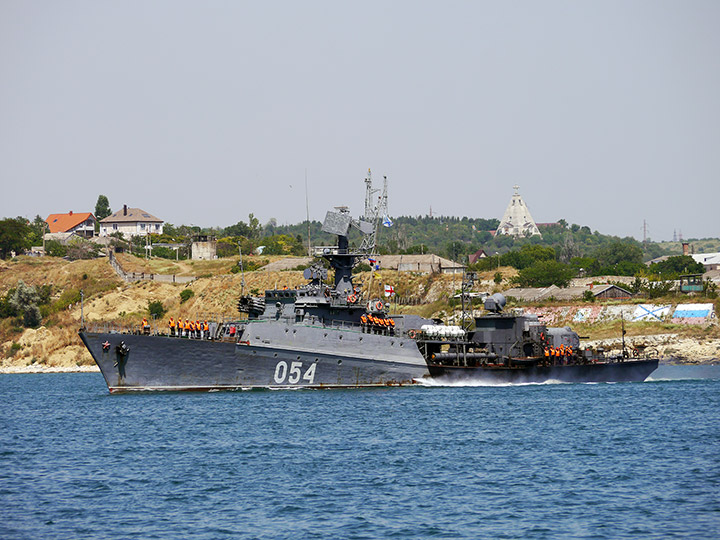
kchf.ru
Russia has strengthened its grouping in the Sea of Azov with the Yeysk small anti-submarine corvette of the Russian Navy's black Sea Fleet.
On July 8, it passed a bridge arch near the city of Kerch, heading for the Sea of Azov, as reported by the Ukrainian military portal.
The Yeysk ship is assigned to the Novorossiysk naval base of the Black Sea Fleet of the Russian navy and is part of the 181st division of small anti-submarine ships of the 184th brigade of water area protection.
In 2017, the vessel underwent dock repairs at the 13th ship repair plant in the Russian-occupied city of Sevastopol.
Major fire erupts at power station in Moscow region
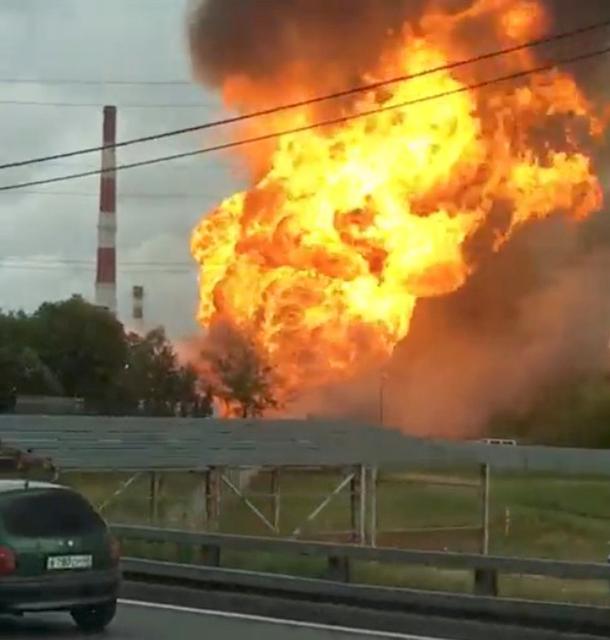
A still image taken from a video footage shows the fire at an electricity generating power station in the Moscow region, Russia July 11, 2019. Instagram/almazov88
A major fire broke out at a power station in the Moscow region on Thursday, injuring six to nine people, the energy ministry and Russian media reports said.
Huge flames could be seen leaping into the sky from Thermal Power Station-27 in the Mytishchi district northeast of Moscow.
Emergency services deployed more than 150 firefighters to the scene, as well as dozens of vehicles including fire engines, helicopters and trains, Zhanna Terekhova, spokeswoman for the emergency services, said on state television.
There was no risk of the fire spreading to residential areas, she said, adding that firefighters hoped to extinguish the blaze within the hour.
Major Fire Kills 1 and Injures 13 at Power Plant Near Moscow - The Moscow Times
 Moskva News Agency
Moskva News Agency
A woman was killed and 13 people were injured in a major fire at a power station in the Moscow region on Thursday that was put out by firefighters, the emergencies ministry and Russian media said.
"The open flames have been extinguished," Interfax cited the emergencies ministry as saying.
Earlier, huge flames could be seen leaping into the sky and black smoke belched from Thermal Power Station-27 in Moscow's Mytishchi district. An eyewitness quoted by the state-run RIA news agency said the flames were 50 meters high.
The Mosenergo power generation company said the fire broke out in a natural gas pipeline outside the power station and the facility's power generating equipment was not damaged.
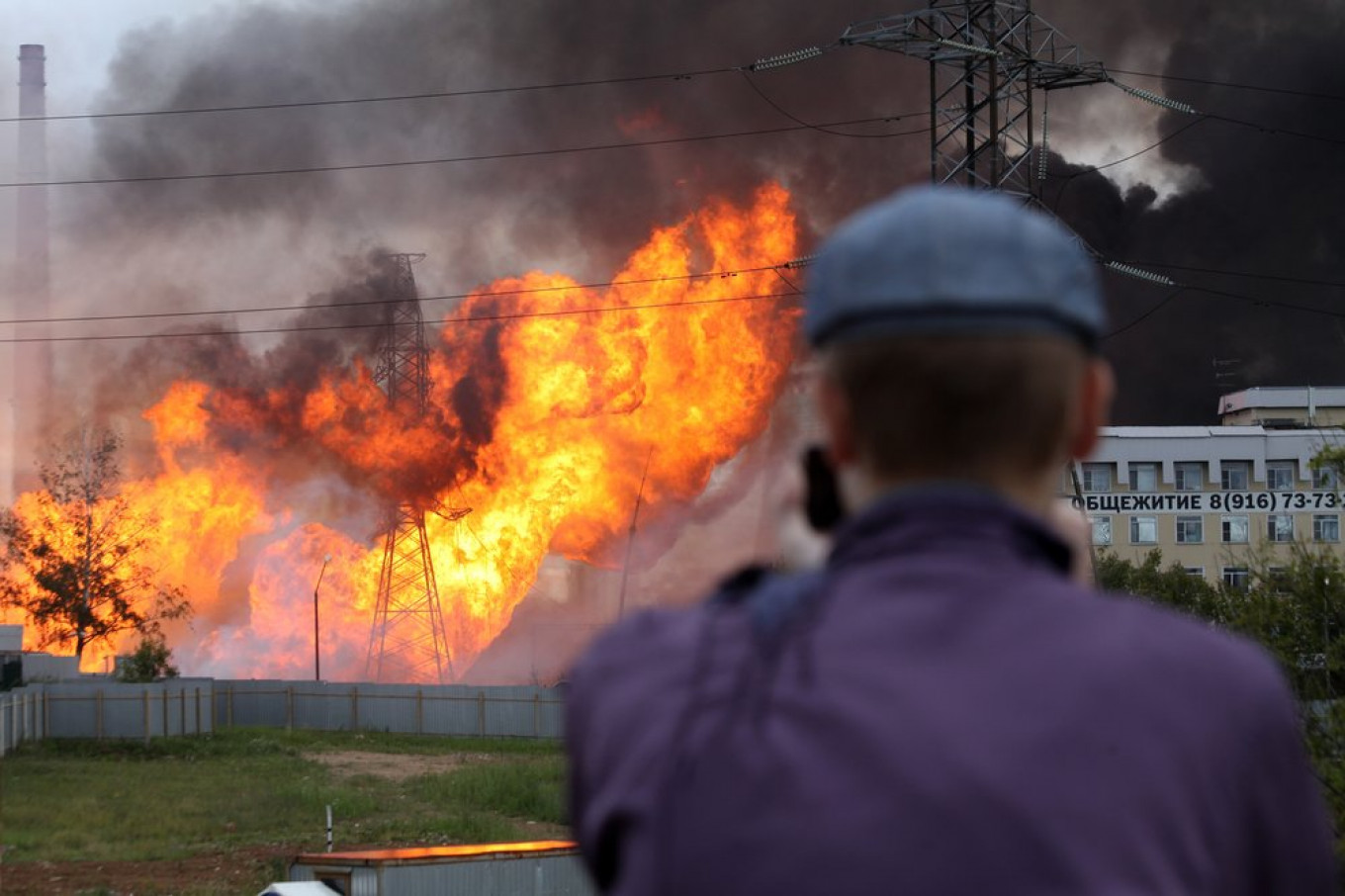
Sergei Vedyashkin / Moskva News Agency
A woman who worked as a guard at the power plant was killed and 13 people were injured, according to emergency services cited by RIA.
Russian police detain Crimean Tatar protesters outside supreme court: monitor

Russian police on Thursday detained over 40 Crimean Tatars who were protesting outside the Supreme Court in Moscow over what they said was the wrongful conviction of four compatriots on terrorism-related charges, a monitoring group said.

kchf.ru
Russia has strengthened its grouping in the Sea of Azov with the Yeysk small anti-submarine corvette of the Russian Navy's black Sea Fleet.
On July 8, it passed a bridge arch near the city of Kerch, heading for the Sea of Azov, as reported by the Ukrainian military portal.
The Yeysk ship is assigned to the Novorossiysk naval base of the Black Sea Fleet of the Russian navy and is part of the 181st division of small anti-submarine ships of the 184th brigade of water area protection.
In 2017, the vessel underwent dock repairs at the 13th ship repair plant in the Russian-occupied city of Sevastopol.
Major fire erupts at power station in Moscow region
A still image taken from a video footage shows the fire at an electricity generating power station in the Moscow region, Russia July 11, 2019. Instagram/almazov88
A major fire broke out at a power station in the Moscow region on Thursday, injuring six to nine people, the energy ministry and Russian media reports said.
Huge flames could be seen leaping into the sky from Thermal Power Station-27 in the Mytishchi district northeast of Moscow.
Emergency services deployed more than 150 firefighters to the scene, as well as dozens of vehicles including fire engines, helicopters and trains, Zhanna Terekhova, spokeswoman for the emergency services, said on state television.
There was no risk of the fire spreading to residential areas, she said, adding that firefighters hoped to extinguish the blaze within the hour.
Major Fire Kills 1 and Injures 13 at Power Plant Near Moscow - The Moscow Times

A woman was killed and 13 people were injured in a major fire at a power station in the Moscow region on Thursday that was put out by firefighters, the emergencies ministry and Russian media said.
"The open flames have been extinguished," Interfax cited the emergencies ministry as saying.
Earlier, huge flames could be seen leaping into the sky and black smoke belched from Thermal Power Station-27 in Moscow's Mytishchi district. An eyewitness quoted by the state-run RIA news agency said the flames were 50 meters high.
The Mosenergo power generation company said the fire broke out in a natural gas pipeline outside the power station and the facility's power generating equipment was not damaged.

Sergei Vedyashkin / Moskva News Agency
A woman who worked as a guard at the power plant was killed and 13 people were injured, according to emergency services cited by RIA.
Russian police detain Crimean Tatar protesters outside supreme court: monitor
Russian police on Thursday detained over 40 Crimean Tatars who were protesting outside the Supreme Court in Moscow over what they said was the wrongful conviction of four compatriots on terrorism-related charges, a monitoring group said.
angelburst29
The Living Force
US, Russian Diplomats to Discuss Strategic Stability in Geneva on July 17-18 - Other Media news - Tasnim News Agency

"Deputy Secretary of State John J. Sullivan will travel to Switzerland and Belgium July 16-18," the document said Friday.
"In Geneva, Switzerland, Deputy Secretary Sullivan will lead the US delegation's participation in a US-Russia strategic security dialogue with Russian Deputy Foreign Minister Ryabkov, in furtherance of discussions by Secretary Pompeo and Russian Foreign Minister Lavrov during their meeting in Sochi, Russia on May 14," the document added, TASS news agency reported.
"Under Secretary of State for Arms Control and International Security Andrea Thompson will accompany the Deputy Secretary," the document noted adding that "Deputy Secretary Sullivana and Under Secretary Thompson will then travel to Brussels, Belgium on July 18 to brief Allies at NATO headquarters."
Ryabkov last held talks with Thompson on June 12 in Prague. The Russian deputy foreign minister said he hopes that the meeting in Geneva will help launch a structured dialogue process on arms control, including on the New Strategic Arms Reduction Treaty (New START).
Russia Rejects Any Discussion of "Transferring" Two Islands: Report - Other Media news - Tasnim News Agency
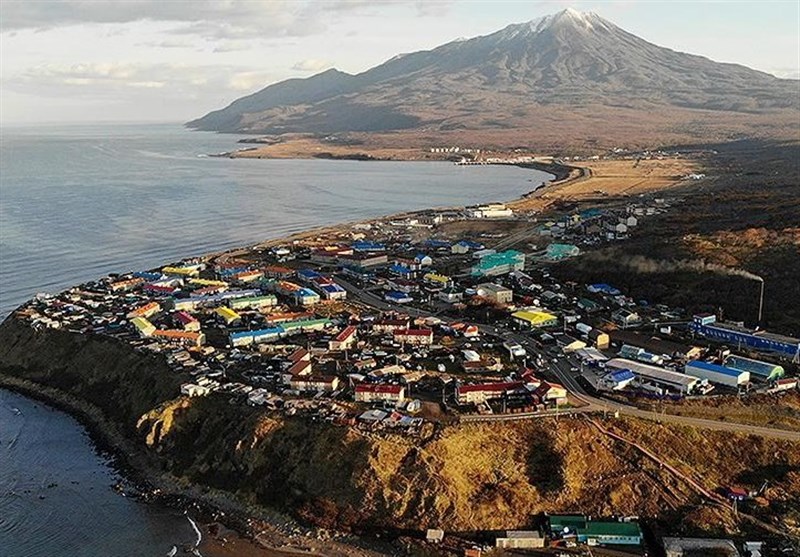
July, 14, 2019 - The news agency reported, citing a source close to the negotiation process, that one of the reasons for Moscow’s refusal to even discuss such an opportunity was Russia’s concerns related to the Japanese-US military alliance.
The refusal also stemmed from fears that a potential compromise on the territorial issue with Japan could have an adverse effect on the level of support for the Russian government by the population, Kyodo News noted.
Dozens detained in Moscow as opposition demands to be included in vote

July 14, 2019 - Police in Moscow detained more than 25 protestors at a rally to demonstrate against a possible ban on opposition candidates running in elections to the Russian capital's parliament.
Ex-owner of Russia's largest independent oil refinery arrested in Moscow
July 14, 2019 - A former owner of the debt-laden Antipinsky refinery, Russia's largest independent oil-processing plant, was arrested in Moscow, his company said in a statement on Sunday.
New Stream group said its head, Dmitry Mazurov, was arrested by the Investigative Committee on Saturday at Moscow’s Sheremetyevo airport when he arrived back in Russia.
It said Mazurov was a suspect in a criminal case, without elaborating. New Stream formerly owned the refinery. Authorities were not immediately available for comment.
Last month, SOCAR Energoresurs, a joint venture between Russia’s largest lender, Sberbank, and a group of investors, acquired an 80% stake in the Antipinsky refinery.. Sberbank is the plant’s main creditor.
The plant, which has an annual capacity of 9 million tonnes, filed for bankruptcy in May, weeks after a London court ordered its assets to be frozen in response to a lawsuit from a trading house.
Court data showed there were 346.5 billion roubles ($5.5 billion) of claims against the refinery.
Moscow court puts rocket center staffer under house arrest on high treason charge
Moscow court puts rocket center staffer under house arrest on high treason charge
July 15, 2019 - Moscow’s Lefortovo court has put under house arrest Sergey Meshcheryakov, a staffer of the Heat Exchange and Aerogas Dynamics Center at the Central Research Institute of Machine Building (TsNIImash), suspected of high treason, court sources told TASS on Monday.
"The Lefortovo district court of Moscow has chosen house arrest until September 3 as a pre-trial restraint for Meshcheryakov Sergey suspected of committing a crime under Article 275 of the Russian Criminal Code (High Treason)," a court representative said.
According to the website of the Russian rocket and spacecraft scientific center, Meshcheryakov is a senior scientific researcher.
Earlier, the court arrested the chief of the Heat Exchange and Aerogas Dynamics Center, Roman Kovalyov, on high treason charges.
Another TsNIImash employee, Viktor Kudryavtsev, 75, was arrested on July 20, 2018. According to a source of TASS, investigators charge him with transferring classified information via e-mail to Belgium’s von Karman Institute for Fluid Dynamics, with which TSNIIMASH (the main research institute of the Roscosmos State Space Corporation) cooperated under an agreement approved by the Russian government.
Putin orders to establish Zhores Alferov Scholarship
Putin orders to establish Zhores Alferov Scholarship
MOSCOW, July 12, 2019 - Russian President Vladimir Putin has ordered the Russian government to establish Zhores Alferov Scholarship for young scientists. The decree was published on Friday on the official web portal of legal information.
The President ordered "to establish 10 personal Zhores Alferov Scholarships for young scientists in the sphere of physics and nanotechnologies starting from 2020.
The head of state also ordered "to settle the issue of assigning Zhores Alferov’s name to the federal state budgetary higher educational and scientific institution ‘St. Petersburg National Research Academic University of the Russian Academy of Sciences.’"
The president recommended that St. Petersburg’s government should make a memorial plaque devoted to the Nobel prize winner.
Zhores Alferov
Alferov was born on March 15, 1930, in Vitebsk. After school graduation he enrolled in St. Petersburg Electronic Technical Institute without entrance examinations, graduated it with honors in 1952. In 1972, he was elected corresponding member of the Soviet Union’s Academy of Sciences and in 1979 he became academician.
In 2000, Zhores Alferov and American scientists Jack Kilby and Herbert Kroemer were awarded Nobel Prize in Physics. Alferov and Kroemer received it for developing semiconductor heterostructures used in high-speed-and opto-electronics and Kilby was awarded for his part in the invention of the integrated circuit.
In 2001, the St. Petersburg Legislative Assembly gave Alferov the freedom of the city. Zhores Alferov died overnight into March 2, 2019, aged 88.

"Deputy Secretary of State John J. Sullivan will travel to Switzerland and Belgium July 16-18," the document said Friday.
"In Geneva, Switzerland, Deputy Secretary Sullivan will lead the US delegation's participation in a US-Russia strategic security dialogue with Russian Deputy Foreign Minister Ryabkov, in furtherance of discussions by Secretary Pompeo and Russian Foreign Minister Lavrov during their meeting in Sochi, Russia on May 14," the document added, TASS news agency reported.
"Under Secretary of State for Arms Control and International Security Andrea Thompson will accompany the Deputy Secretary," the document noted adding that "Deputy Secretary Sullivana and Under Secretary Thompson will then travel to Brussels, Belgium on July 18 to brief Allies at NATO headquarters."
Ryabkov last held talks with Thompson on June 12 in Prague. The Russian deputy foreign minister said he hopes that the meeting in Geneva will help launch a structured dialogue process on arms control, including on the New Strategic Arms Reduction Treaty (New START).
Russia Rejects Any Discussion of "Transferring" Two Islands: Report - Other Media news - Tasnim News Agency

July, 14, 2019 - The news agency reported, citing a source close to the negotiation process, that one of the reasons for Moscow’s refusal to even discuss such an opportunity was Russia’s concerns related to the Japanese-US military alliance.
The refusal also stemmed from fears that a potential compromise on the territorial issue with Japan could have an adverse effect on the level of support for the Russian government by the population, Kyodo News noted.
Dozens detained in Moscow as opposition demands to be included in vote
July 14, 2019 - Police in Moscow detained more than 25 protestors at a rally to demonstrate against a possible ban on opposition candidates running in elections to the Russian capital's parliament.
Ex-owner of Russia's largest independent oil refinery arrested in Moscow
July 14, 2019 - A former owner of the debt-laden Antipinsky refinery, Russia's largest independent oil-processing plant, was arrested in Moscow, his company said in a statement on Sunday.
New Stream group said its head, Dmitry Mazurov, was arrested by the Investigative Committee on Saturday at Moscow’s Sheremetyevo airport when he arrived back in Russia.
It said Mazurov was a suspect in a criminal case, without elaborating. New Stream formerly owned the refinery. Authorities were not immediately available for comment.
Last month, SOCAR Energoresurs, a joint venture between Russia’s largest lender, Sberbank, and a group of investors, acquired an 80% stake in the Antipinsky refinery.. Sberbank is the plant’s main creditor.
The plant, which has an annual capacity of 9 million tonnes, filed for bankruptcy in May, weeks after a London court ordered its assets to be frozen in response to a lawsuit from a trading house.
Court data showed there were 346.5 billion roubles ($5.5 billion) of claims against the refinery.
Moscow court puts rocket center staffer under house arrest on high treason charge
Moscow court puts rocket center staffer under house arrest on high treason charge
July 15, 2019 - Moscow’s Lefortovo court has put under house arrest Sergey Meshcheryakov, a staffer of the Heat Exchange and Aerogas Dynamics Center at the Central Research Institute of Machine Building (TsNIImash), suspected of high treason, court sources told TASS on Monday.
"The Lefortovo district court of Moscow has chosen house arrest until September 3 as a pre-trial restraint for Meshcheryakov Sergey suspected of committing a crime under Article 275 of the Russian Criminal Code (High Treason)," a court representative said.
According to the website of the Russian rocket and spacecraft scientific center, Meshcheryakov is a senior scientific researcher.
Earlier, the court arrested the chief of the Heat Exchange and Aerogas Dynamics Center, Roman Kovalyov, on high treason charges.
Another TsNIImash employee, Viktor Kudryavtsev, 75, was arrested on July 20, 2018. According to a source of TASS, investigators charge him with transferring classified information via e-mail to Belgium’s von Karman Institute for Fluid Dynamics, with which TSNIIMASH (the main research institute of the Roscosmos State Space Corporation) cooperated under an agreement approved by the Russian government.
Putin orders to establish Zhores Alferov Scholarship
Putin orders to establish Zhores Alferov Scholarship
MOSCOW, July 12, 2019 - Russian President Vladimir Putin has ordered the Russian government to establish Zhores Alferov Scholarship for young scientists. The decree was published on Friday on the official web portal of legal information.
The President ordered "to establish 10 personal Zhores Alferov Scholarships for young scientists in the sphere of physics and nanotechnologies starting from 2020.
The head of state also ordered "to settle the issue of assigning Zhores Alferov’s name to the federal state budgetary higher educational and scientific institution ‘St. Petersburg National Research Academic University of the Russian Academy of Sciences.’"
The president recommended that St. Petersburg’s government should make a memorial plaque devoted to the Nobel prize winner.
Zhores Alferov
Alferov was born on March 15, 1930, in Vitebsk. After school graduation he enrolled in St. Petersburg Electronic Technical Institute without entrance examinations, graduated it with honors in 1952. In 1972, he was elected corresponding member of the Soviet Union’s Academy of Sciences and in 1979 he became academician.
In 2000, Zhores Alferov and American scientists Jack Kilby and Herbert Kroemer were awarded Nobel Prize in Physics. Alferov and Kroemer received it for developing semiconductor heterostructures used in high-speed-and opto-electronics and Kilby was awarded for his part in the invention of the integrated circuit.
In 2001, the St. Petersburg Legislative Assembly gave Alferov the freedom of the city. Zhores Alferov died overnight into March 2, 2019, aged 88.
angelburst29
The Living Force
According to a source in the emergencies services, the privately-owned Robinson helicopter crashed near the city of Solnechnogorsk.
Chief of Russia’s Ultralight Aviation Federation dies in helicopter crash near Moscow
MOSCOW, July 14, 2019 - Chief of Russia’s Ultralight Aviation Federation Igor Nikitin died in a Robinson helicopter crash near Moscow, a spokesman for that organization told TASS on Sunday.
"According to our information, Nikitin has died. The cause of the crash has not yet been identified," he said.
According to a source in the emergencies services, the privately-owned Robinson helicopter crashed near the city of Solnechnogorsk outside Moscow. The pilots reportedly had no flight permit.
Russia ranks second in overall medal standing at Universiade in Naples with 82 medals

© Vladimir Smirnov/TASS
July 14, 2019 - Russia’s national team has made it to the second place in the overall medal standing at the Summer Universiade in Italy’s Naples, with 82 medals, including 22 gold, 24 silver and 36 bronze ones.
One set of medals was contested on Sunday, the last day of competitions. Russian water polo players lost to Hungary in the bronze medals game.
Most of Russia’s medals - 18 - were grabbed by swimmers (six gold, six silver and six bronze). Thirteen medals (one gold, six silver and six bronze ones) went to Russian artistic gymnasts. The rhythmic gymnastics team won eight medals (seven gold and one bronze), and ten medals (three gold, two silver and five bronze) were won by Russian judokas.
Six medals were won by Russian divers (two silver and four bronze) and fencers (one gold, four silver and one bronze). Russian archers won four medals (two gold and two silver). Two bronze medals were grabbed in shooting competitions. Russian tennis players grabbed four medals (one gold, one silver and two bronze), the table tennis team won four bronze medals, and one silver and one bronze medals went to Russia in taekwondo.
Russian women’s volleyball team grabbed gold medals, and men’s team - bronze medals, as did women’s football, water polo and rugby teams.
Russia shares the first place with Japan in terms of the overall number of medals won. Japan has 33 gold, 21 silver and 28 bronze medals and tops the overall medal standing. China is third, with 22 gold, 13 silver and eight medals.
The Univesiade closing ceremony will be held later on Sunday.
Chief of Russia’s Ultralight Aviation Federation dies in helicopter crash near Moscow
MOSCOW, July 14, 2019 - Chief of Russia’s Ultralight Aviation Federation Igor Nikitin died in a Robinson helicopter crash near Moscow, a spokesman for that organization told TASS on Sunday.
"According to our information, Nikitin has died. The cause of the crash has not yet been identified," he said.
According to a source in the emergencies services, the privately-owned Robinson helicopter crashed near the city of Solnechnogorsk outside Moscow. The pilots reportedly had no flight permit.
Russia ranks second in overall medal standing at Universiade in Naples with 82 medals

© Vladimir Smirnov/TASS
July 14, 2019 - Russia’s national team has made it to the second place in the overall medal standing at the Summer Universiade in Italy’s Naples, with 82 medals, including 22 gold, 24 silver and 36 bronze ones.
One set of medals was contested on Sunday, the last day of competitions. Russian water polo players lost to Hungary in the bronze medals game.
Most of Russia’s medals - 18 - were grabbed by swimmers (six gold, six silver and six bronze). Thirteen medals (one gold, six silver and six bronze ones) went to Russian artistic gymnasts. The rhythmic gymnastics team won eight medals (seven gold and one bronze), and ten medals (three gold, two silver and five bronze) were won by Russian judokas.
Six medals were won by Russian divers (two silver and four bronze) and fencers (one gold, four silver and one bronze). Russian archers won four medals (two gold and two silver). Two bronze medals were grabbed in shooting competitions. Russian tennis players grabbed four medals (one gold, one silver and two bronze), the table tennis team won four bronze medals, and one silver and one bronze medals went to Russia in taekwondo.
Russian women’s volleyball team grabbed gold medals, and men’s team - bronze medals, as did women’s football, water polo and rugby teams.
Russia shares the first place with Japan in terms of the overall number of medals won. Japan has 33 gold, 21 silver and 28 bronze medals and tops the overall medal standing. China is third, with 22 gold, 13 silver and eight medals.
The Univesiade closing ceremony will be held later on Sunday.
angelburst29
The Living Force
Indian frigate and Chinese destroyer to take part in Russian Navy Day parade
Indian frigate and Chinese destroyer to take part in Russian Navy Day parade
 © Peter Kovalev/TASS
© Peter Kovalev/TASS
MOSCOW, July 22, 2019 - China's destroyer Xian and India's frigate Tarkash will take part in the military maritime parade that will be held in St. Petersburg on July 28. the Russian Defense Ministry said on Monday.
According to the Krasnaya Zvezda newspaper, over 40 ships will take part in the parade in celebration of the Russian Navy Day, along with over 40 aircraft and helicopters, as well as over 4,000 servicemen.
Among ships that will take part in the parade are the newest Project 22350 frigates Admiral Kasatonov and Admiral Gorshkov, Project 677 submarine Kronstadt, cruiser Marshal Ustinov and nuclear-powered submarine Smolensk.
Among aicraft that will take part in the parade are Su-33 and MiG-29K fighter jets, Su-30SM fighter, anti-submarine warfare aircraft Tu-142 and Il-38N, and multipurporse amphibious aircraft Be-200.
Indian frigate and Chinese destroyer to take part in Russian Navy Day parade

MOSCOW, July 22, 2019 - China's destroyer Xian and India's frigate Tarkash will take part in the military maritime parade that will be held in St. Petersburg on July 28. the Russian Defense Ministry said on Monday.
According to the Krasnaya Zvezda newspaper, over 40 ships will take part in the parade in celebration of the Russian Navy Day, along with over 40 aircraft and helicopters, as well as over 4,000 servicemen.
Among ships that will take part in the parade are the newest Project 22350 frigates Admiral Kasatonov and Admiral Gorshkov, Project 677 submarine Kronstadt, cruiser Marshal Ustinov and nuclear-powered submarine Smolensk.
Among aicraft that will take part in the parade are Su-33 and MiG-29K fighter jets, Su-30SM fighter, anti-submarine warfare aircraft Tu-142 and Il-38N, and multipurporse amphibious aircraft Be-200.
angelburst29
The Living Force
Russia says it will ban think tank formerly run by U.S. ambassador
MOSCOW (Reuters) - Russia said on Thursday it was preparing to ban the Atlantic Council, a think tank formerly run by the U.S. ambassador to Moscow, which Russia’s prosecutor general described as a security threat.
“It has been established that the activities of this organization present a threat to the fundamentals of the constitutional order and security of the Russian Federation,” the prosecutor general’s office said. It gave no further details of the reasons for the ban.
The move follows steps taken by Moscow against several other foreign non-government organizations since Russia’s relations with the West deteriorated over the Ukrainian crisis in 2014 and financial sanctions that followed.
The General Prosecutor’s Office said it had handed over its ruling to the Russian ministry of justice.
A spokeswoman for the Atlantic Council in Washington could not be reached by telephone and did not immediately respond to an emailed request for comment.
U.S. ambassador Jon Huntsman served as chairman of the think tank from 2014 until 2017, when he was appointed to his diplomatic post by President Donald Trump.
UN nuclear watchdog confirms Cornel Feruta's appointment as IAEA acting chief

Cornel Feruta © flickr.com/Dean Calma/IAEA/CC BY-SA 2.0
VIENNA, July 25, 2019 - The Board of Governors of the International Atomic Energy Agency (IAEA) has decided to appoint Romania’s former Permanent Representative at International Organizations in Vienna Cornel Feruta as the organization’s acting chief after Yukiya Amano’s death, the UN nuclear watchdog issued a statement on Thursday.
"As a consequence of the recent passing away of Director General Yukiya Amano, and in order to ensure the orderly and smooth functioning of the Agency, the Board of Governors has decided to designate Mr. Cornel Feruta as Acting Director General, until a Director General assumes office," the statement says.
Russia’s Permanent Representative at International Organizations in Vienna Mikhail Ulyanov announced earlier on Thursday that Feruta had been appointed as the IAEA acting chief. According to Ulyanov, Feruta was the closest assistant of the late Yukiya Amano and coordinated the IAEA activity in several areas. "He will be working as the acting head before a new Director General who will have to be elected takes office," Ulyanov wrote in his Twitter.
MOSCOW (Reuters) - Russia said on Thursday it was preparing to ban the Atlantic Council, a think tank formerly run by the U.S. ambassador to Moscow, which Russia’s prosecutor general described as a security threat.
“It has been established that the activities of this organization present a threat to the fundamentals of the constitutional order and security of the Russian Federation,” the prosecutor general’s office said. It gave no further details of the reasons for the ban.
The move follows steps taken by Moscow against several other foreign non-government organizations since Russia’s relations with the West deteriorated over the Ukrainian crisis in 2014 and financial sanctions that followed.
The General Prosecutor’s Office said it had handed over its ruling to the Russian ministry of justice.
A spokeswoman for the Atlantic Council in Washington could not be reached by telephone and did not immediately respond to an emailed request for comment.
U.S. ambassador Jon Huntsman served as chairman of the think tank from 2014 until 2017, when he was appointed to his diplomatic post by President Donald Trump.
UN nuclear watchdog confirms Cornel Feruta's appointment as IAEA acting chief

Cornel Feruta © flickr.com/Dean Calma/IAEA/CC BY-SA 2.0
VIENNA, July 25, 2019 - The Board of Governors of the International Atomic Energy Agency (IAEA) has decided to appoint Romania’s former Permanent Representative at International Organizations in Vienna Cornel Feruta as the organization’s acting chief after Yukiya Amano’s death, the UN nuclear watchdog issued a statement on Thursday.
"As a consequence of the recent passing away of Director General Yukiya Amano, and in order to ensure the orderly and smooth functioning of the Agency, the Board of Governors has decided to designate Mr. Cornel Feruta as Acting Director General, until a Director General assumes office," the statement says.
Russia’s Permanent Representative at International Organizations in Vienna Mikhail Ulyanov announced earlier on Thursday that Feruta had been appointed as the IAEA acting chief. According to Ulyanov, Feruta was the closest assistant of the late Yukiya Amano and coordinated the IAEA activity in several areas. "He will be working as the acting head before a new Director General who will have to be elected takes office," Ulyanov wrote in his Twitter.
The IAEA Board of Governors held a special session on Thursday to pay tribute to the organization’s late chief Yukiya Amano and discuss the pending appointment of the UN nuclear watchdog’s acting head.
"Intensive consultations on the timeframe of electing a new IAEA Director General will take place in coming days. Normally, the election takes about a year. In view of Amano’s death, this process should be expedited," the Russian permanent envoy wrote in his Twitter.
In accordance with the IAEA procedures, the Board of Governors makes a decision on appointing a Director General in a vote. Each candidate should be nominated by a country and be supported by a majority of the IAEA Board of Governors' members. The candidature endorsed by the Board of Governors is subsequently approved at the IAEA General Conference held annually in autumn. The IAEA regular 63rd conference is scheduled for September 16-20.
Yukiya Amano died at the age of 72 on July 22. The 72-year old Japanese diplomat headed the IAEA since December 2009. In September 2017, Amano’s candidacy was approved for the third four-year term in a row to lead the organization until November 30, 2021. It was earlier reported that Amano might leave his post prematurely in March 2020 due to his illness.
Amano’s tenure saw the signing of the historic Joint Comprehensive Plan of Action (JCPOA) on the Iranian nuclear program. The JCPOA agreed by Tehran and six world powers (five permanent members of the UN Security Council and Germany) was inked on July 14, 2015 in Vienna.
angelburst29
The Living Force
Kremlin critic Navalny jailed for 30 days for calling protest

Kremlin critic Alexei Navalny was jailed for 30 days on Wednesday, his spokeswoman said, ahead of a march he planned to lead in Moscow in protest at the exclusion of several opposition-minded candidates from a local election in September.
Russian opposition vows to hold Moscow protest despite crackdown

Russian opposition activists said on Thursday they planned to press ahead with an unauthorized rally in Moscow this weekend despite overnight police searches and a raft of detentions, including the jailing of Kremlin critic Alexei Navalny.
Protesters briefly block traffic on Moscow's ring road: Reuters witnesses
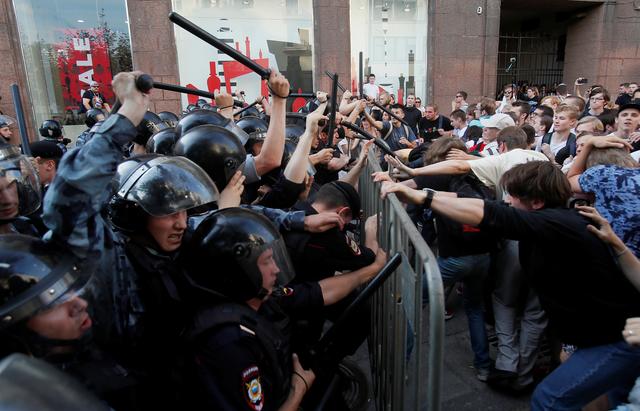
Protesters demanding the opposition be allowed to run in local elections in Moscow this year briefly brought traffic to a halt on the city's garden ring road on Saturday, one of the Russian capital's main arteries, Reuters witnesses said.
Russia detains more than 1,000 people in opposition crackdown
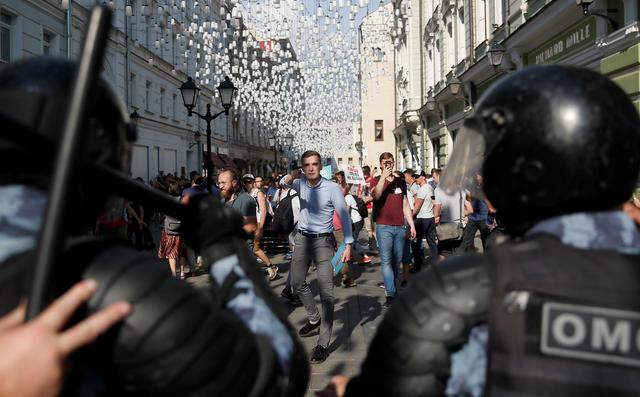
Russian police rounded up more than 1,000 people in Moscow on Saturday in one of the biggest crackdowns of recent times against an increasingly defiant opposition decrying President Vladimir Putin's tight grip on power.
Kremlin critic Alexei Navalny was jailed for 30 days on Wednesday, his spokeswoman said, ahead of a march he planned to lead in Moscow in protest at the exclusion of several opposition-minded candidates from a local election in September.
Russian opposition vows to hold Moscow protest despite crackdown
Russian opposition activists said on Thursday they planned to press ahead with an unauthorized rally in Moscow this weekend despite overnight police searches and a raft of detentions, including the jailing of Kremlin critic Alexei Navalny.
Protesters briefly block traffic on Moscow's ring road: Reuters witnesses
Protesters demanding the opposition be allowed to run in local elections in Moscow this year briefly brought traffic to a halt on the city's garden ring road on Saturday, one of the Russian capital's main arteries, Reuters witnesses said.
Russia detains more than 1,000 people in opposition crackdown
Russian police rounded up more than 1,000 people in Moscow on Saturday in one of the biggest crackdowns of recent times against an increasingly defiant opposition decrying President Vladimir Putin's tight grip on power.
Indian frigate and Chinese destroyer to take part in Russian Navy Day parade
G- Translate
Before the beginning of the Main naval parade on the Day of the Navy, which will be held in St. Petersburg, there are three hours left. For the first time, for the celebration of the Navy Day, ships of other countries came to St. Petersburg - the Indian Navy frigate Tarkash and the Xian destroyer of the Chinese Navy.
Putin bypassed the front line of warships on the Kronstadt raid by boat: (link: http://go.tass.ru/ri9D) go.tass.ru/ri9D
In the Irkutsk Region, schoolchildren from flood families will be fed free of charge: (link: http://go.tass.ru/rigc) go.tass.ru/rigc
Edit Add:
Trending content
-
-
Thread 'Coronavirus Pandemic: Apocalypse Now! Or exaggerated scare story?'
- wanderingthomas
Replies: 30K -
Thread 'Mass Shooting at Bondi Beach, Sydney, targets Jews celebrating Hanukkah'
- Rhythmik
Replies: 133 -
